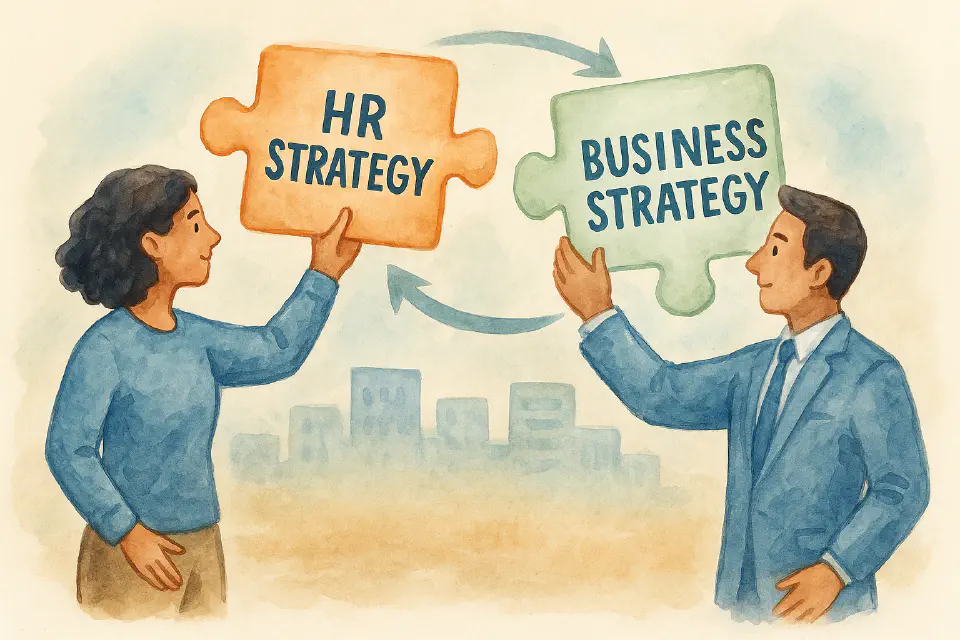
Aligning HR Strategy with Business Strategy
Everyone says HR should align with business strategy. But what does that actually mean—and why do so many organizations still get it wrong? In this guide, we unpack the disconnect, reveal the business risks of poor alignment, and show how HR can take the lead in driving measurable value.
Strategic alignment between HR and business isn’t just a best practice anymore — it’s a competitive necessity. In a world shaped by constant disruption, HR leaders can no longer afford to simply “support” the business. They must become co-architects of strategy, translating bold goals into people-powered execution. Yet, despite best intentions, the link between HR initiatives and business outcomes often remains invisible or misunderstood.
This article explores why aligning HR and business strategies is critical, what happens when this connection is broken, and how HR can become a driving force behind organizational success. From missed opportunities to budget cuts, we’ll dive deep into what misalignment costs and offer a step-by-step approach to get — and stay — aligned.
The Business-HR Disconnect: Why It Happens
HR professionals know they need to align with business goals. Our data shows that most HR leaders work hard to cascade strategic objectives, define relevant KPIs, and show their impact. But somewhere along the way, the message gets lost. Business leaders often don’t recognize how HR’s work moves the needle on business priorities.
Why? Because HR isn’t always invited to shape the strategy — just to respond to it. Even when HR designs initiatives that clearly support business outcomes (like integrating culture post-acquisition), the link often remains unspoken, misunderstood, or taken for granted.
And unlike Finance or Marketing — functions whose concepts most executives understand — HR still suffers from limited business fluency across the C-suite. Many leaders don’t fully grasp the science behind HR practices, relying instead on outdated assumptions or anecdotal experiences.
Why HR-Business Alignment Matters More Than Ever
Research consistently shows that companies with aligned HR and business strategies outperform their peers. Strategic workforce planning, data-driven development programs, and incentive models tied to business priorities all correlate with higher profitability, productivity, and retention.
But beyond numbers, alignment builds credibility. It helps HR shed its legacy image as a cost center and take its place as a value creator. When leaders see HR as instrumental to solving real business problems — from declining customer satisfaction to sluggish innovation — HR earns a seat at the strategy table by right, not request.
The Risks of Misalignment
When HR and business strategies drift apart, the consequences aren’t just theoretical. They show up in three painful ways:
- Misallocated resources: HR teams spend time and budget on initiatives that feel irrelevant or tangential to the business (e.g. launching a new well-being app during a cost-cutting period).
- Lost credibility: When the ROI of HR isn’t clear, leaders begin to question its value. HR is seen as tactical at best, disconnected at worst.
- Budget erosion: In tight times, functions that don’t demonstrate business impact lose influence and funding — sometimes fatally.
Five Steps to Intentional Alignment
Aligning HR with business isn’t about better reporting. It’s about thinking — and acting — differently. Here’s a structured approach HR leaders can use to drive alignment with intent.
Step 1: Understand the Business Strategy Deeply
Don’t just memorize goals — understand what’s behind them. What’s driving the strategy? How does the company plan to win? What are the key value levers and risks?
This context is vital. Without it, HR risks building disconnected initiatives that sound good on paper but solve the wrong problems.
Step 2: Translate Strategy into People Contributions
Once you understand the strategy, map out what HR needs to contribute for it to succeed. These are called contribution statements.
For example:
- Business goal: Enter a new market segment within 12 months.
- HR contribution: Recruit 50 new customer-facing employees with relevant experience, implement onboarding in 30 days, and align performance incentives to customer acquisition.
The power of contribution statements is clarity. They link HR actions directly to business goals — no interpretation required.
Step 3: Align Resources with Priorities
Strategy without resource alignment is just wishful thinking. HR must now structure its budget, time, teams, and initiatives around the contribution statements.
That means:
- Prioritizing some projects.
- Postponing or stopping others.
- Redirecting capabilities to what matters most.
This is where strategic courage comes in. Saying “no” to legacy programs that no longer serve the business is part of alignment.
Step 4: Connect the Dots for Stakeholders
Even the best-aligned HR strategy fails if no one understands it. HR must proactively tell the story:
Because the business is doing X, HR will focus on Y, which drives Z.
This narrative loop makes HR’s role visible and relevant. And it invites co-ownership of success.
Step 5: Reiterate and Reinforce
Alignment is not a one-time project. It’s a continuous conversation. HR must:
- Revisit goals quarterly.
- Share progress with clarity.
- Re-anchor HR activities as business priorities shift.
In doing so, HR builds not just alignment — but trust, credibility, and strategic partnership.
Final Thoughts
Aligning HR strategy with business strategy isn’t a trend — it’s a threshold. It defines whether HR remains reactive and peripheral, or becomes proactive and pivotal. The path to alignment requires more than reporting on KPIs. It requires strategic fluency, operational courage, and relentless communication.
The reward? HR that drives growth, not just supports it. And organizations where people strategy is business strategy — not an afterthought, but a competitive advantage.